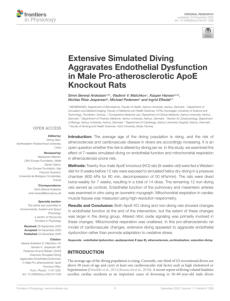Scientific papers 2020 - Part B









Authors:
Adam E Howard, Peter Buzzacott, Ian C Gawthrope, Neil
D Banham
Middle ear barotrauma (MEBt) is a common side effect of
hyperbaric oxygen treatment (HBOT) and can result in
pain, hearing loss, tinnitus, and otorrhagia. The use of
antiplatelet/anticoagulant drugs is thought to increase the
risk and severity of MEBt during HBOT.
The authors studied all patients treated with HBOT over
four years (between 01 January 2015 to 31 December
2018), looking at the incidence of MEBt and the
concurrent use of antiplatelet and/or anticoagulant drugs.
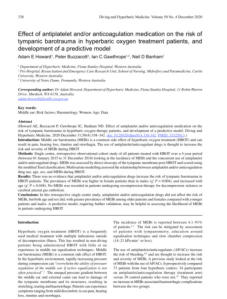

Authors:
Wen-tao Meng, Long Qing, Quan Zhou, Wei-gang Xu
The lung is among the primary organs involved in
decompression sickness (DCS). Xuebijing (XBJ), a
traditional Chinese medicine, has been widely used in the
treatment of various acute lung diseases. This study aimed
to explore potential benefit of XBJ on lung injuries induced
by DCS in a rabbit model.
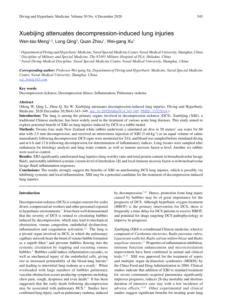

Authors:
Moritz F Meyer, Kristijana Knezic, Stefanie Jansen, Heinz D
Klünter, Eberhard D Pracht, Maria Grosheva
During descent in freediving there is exposure to rapidly
increasing pressure. Inability to quickly equalise middle ear
pressure may cause trauma to the ear. This study aimed to
evaluate the occurrence of pressure-related damage to
the middle ear and the Eustachian tube during freediving
and to identify possible risk factors.
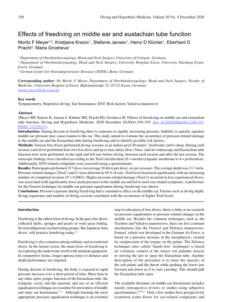

Authors:
Daniel Popa, Anthony Medak, Walter Chin, Oswaldo
Huchim-Lara, 2 scientists, Tudor Hughes, Ian Grover.
Artisanal diving fishermen in Yucatan, Mexico have high
rates of decompression sickness as a result of frequently
unsafe diving practices with surface supplied compressed
air. In this study, the authors investigated the prevalence of
dysbaric osteonecrosis (DON), a type of avascular necrosis,
in the most susceptible joints in a cohort of these
fishermen.
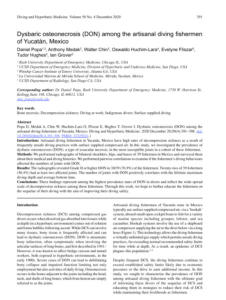

Authors:
Christopher W Scarff, John Lippmann, Andrew W Fock
The presence of a persistent (patent) foramen ovale (PFO)
increases the risk of decompression sickness (DCS) whilst
diving with pressurised air. After the diagnosis of a PEO,
divers will be offered a number of options for risk
mitigation.
The aim of this study was to review the management
choices and modifications to diving practices following
PFO diagnosis in the era preceding the 2015 joint
position statement (JPS) on PEO and diving.
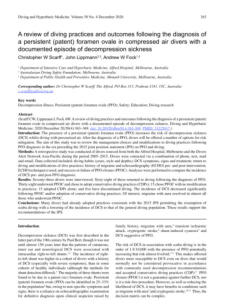

Author:
Charles H Van Wijk, Jarred H Martin, Nazneen Firfi rey
Breath-ho
A recent article reported on common mental health
conditions among recreational scuba divers, and observed
that the prevalence mirrored national population figures.
That raised the question of the extent to which this might
also be the case among professional divers. No data on
commercial divers could be located; this paper presents
the situation among navy divers.
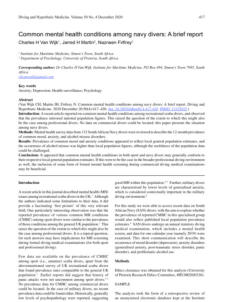

Authors:
Xavier CE Vrijdag, Hanna van Waart, Jamie W Sleigh,
Costantino Balestra, Simon J Mitchell
Critical flicker fusion frequency (CFFF) has been used in
various studies to measure the cognitive effects of gas
mixtures at depth, sometimes with conflicting or
apparently paradoxical results. This study aimed to
evaluate a novel automatic CFFF method and investigate
whether CFFF can be used to monitor gas-induced
nareosis in divers.
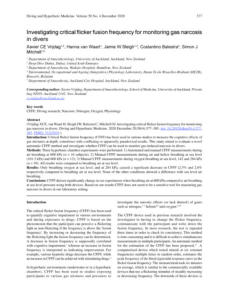

Author: Richard Clarke
This paper summarises the history and capabilities of
monoplace chambers in treatment of decompression
illness (DCI); both in support of diving operations and in
the hospital setting. In the field, monoplace hyperbaric
chambers provide victims of DCI immediate access to
recompression in settings where traditional multiplace
chambers are not available.

Authors: Simona Mrakic-Sposta, Alessandra Vezzoli,
Federica D’Alessandro, Matteo Paganini, Cinzia
Dellanoce, Danilo Cialoni, and Gerardo Bosco
This study investigated the effects of saturation diving on
oxidative stress damage. Four divers were included in the
study. After the saturation dive (post), significant increases
in reactive oxygen species (ROS), total antioxidant capacity
(TAC), total antioxidant capacity (TAC), and nitric oxide
metabolites (NOx) were detected.
The authors say that these results could ameliorate
commercial or military diving protocols or improve the
understanding of symptoms caused by oxygen level
elevation.
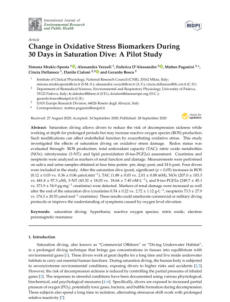

Authors: Ran Arieli, and Ben Aviner
This short article confirms that there is a process of
acclimatization and possibly deacclimatization to oxygen,
which makes it necessary to review the safe exposure
limits. It can be seen as a part and the continuation of
previous works undertaken by doctors Ran Arieli and Ben
Aviner regarding oxygen toxicity.
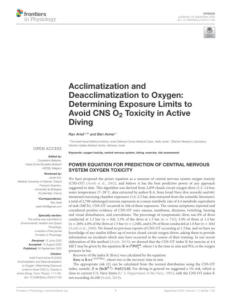


Authors:
Patrick J. Kirkland, Dana Mathew, Pranav Modi, & Jeffrey S.
Cooper
Nitrogen narcosis is a change in consciousness,
neuromuscular function, and behavior brought on by
breathing compressed inert gasses. It has also been called
depth intoxication, ”narks,” and rapture of the deep.
Traditionally the gas involved in narcosis is nitrogen, and it
is associated with dysfunction when breathed by scuba
divers from their tanks containing compressed air. Other
inert gasses associated with narcosis include neon, argon,
krypton, and xenon, with the latter having an anesthetic
effect even at sea level. Interestingly, helium does not
cause inert gas narcosis and therefore, is used in deep
diving as heliox.


Authors: Aida Carballo-Fazanes, Joost J.L.M. Bierens, and
the International Expert Group to Study
Drowning Behaviour
Although drowning is a common phenomenon, the
behaviour of drowning persons is poorly understood.
The purpose of this study is to provide a quantitative and
qualitative analysis of this behaviour. This was an
observational study of drowning videos observed by 20
international experts in the field of water safety. For
quantitative analysis, each video was analysed with Lince
observation software by four participants. A Nominal
Group Technique generated input for the qualitative
analysis and the two principal investigators conducted a
post-hoc analysis.
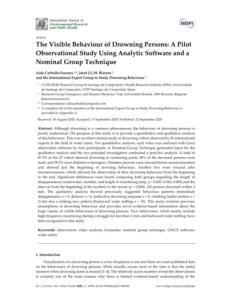

Authors: Ewa Manka, Bartosz Skuratowicz, Sebastian
Kwiatek, Maciej Krupowies, Karolina Sieron
Due to the high prevalence of diabetes mellitus in the
world population and the potential for dangerous
complications during diving, there is a need for unified
recommendations for safe diving with this condition.
Current guidelines from international diving associations
are not entirely consistent. This review presents the
positions of international diving associations concerning
the requirements for diving with diabetes, the scope of
diving and recommended management of life-threatening
conditions during the dive.
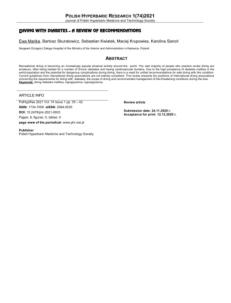
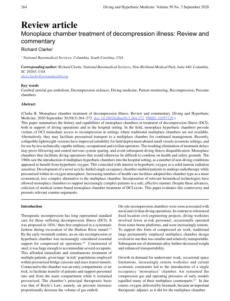

Authors: Maja Schlittler, Hannes Gatterer, Rachel Turner,
Ivo B. Regli, Simon Woyke, Giacomo Strapazzon,
Peter Rasmussen, Michael Kob, Thomas Mueller,
Jens P. Goetze, Marc Maillard, Gerrit van Hall, Eric
Feraille, and Christoph Siebenmann
The authors investigated the effect of hypobaric hypoxia
(HH) on plasma volume (PV) in a crossover study that
strictly controlled for diet, water intake, physical activity,
and temperature.
Eleven males completed two 4-day sojourns in a
hypobaric chamber, one in normoxia (NX) and one in
hypobaric hypoxia (HH) equivalent to 3500 m altitude.
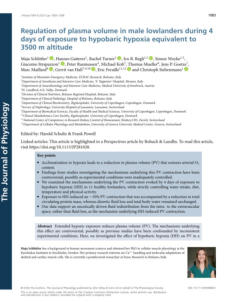

Click on the octopus
to return to the top
of the page

Authors: Huseyin Karakaya, Serkan Aksu, Salih Murat Egi,
Salih Aydin, Atilla Uslu
The authors investigated the cognitive effects of simulated
air environments (500 kPa) on recreational scuba divers.
It was observed that nitrogen narcosis at a pressure of
500 kPa in a dry hyperbaric chamber had a mild to
moderate negative effect on the cognitive performance of
recreational air divers, which threatens the safety of
diving. Although relatively reduced, this effect persisted in
post-dive sessions. These adverse effects are significant for
open water divers. The results have important implications
for preventing nitrogen narcosis and diving accidents at
depths of up to 40 msw.
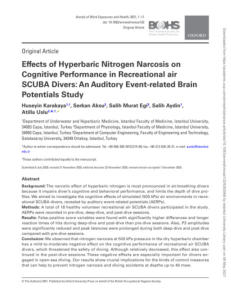

Authors: Andreas Fichtner, Anne Münch, Denise Preuss,
Thomas Pohl, Thomas Grab, Tobias Fieback,
Thea Koch
Audio Doppler bubble measurements for estimating
supersaturation are typically performed in specialized
professional environments and are not accessible to the
wider community of recreational divers. However, the
authors believe that if recreational divers, regardless of
their medical and ultrasound training background, could
master audio Doppler self-assessment to reliably grade
bubbles with a single effective training session, this skill
could greatly improve diving safety.
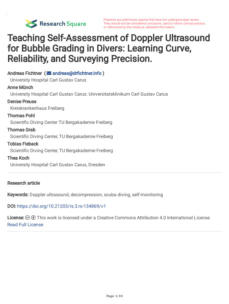

Authors: Ke Ning, Zhen-biao Guan, Hong-tao Lu, Ning
Zhang, Xue-jun Sun, Wen-wu Liu
This study establishes a model of decompression-induced
lung injury (DILI) secondary to repetitive diving in mice,
explores the role of macrophages in DILI, and investigates
the protective effects of high-concentration hydrogen
(HCH) on DILI. It divided mice into three groups (control,
DILI, and HCH), subjecting them to hyperbaric air
exposure followed by decompression and then
administering HCH to one group. Various tests and
analyses of lung function, inflammatory responses, and
macrophage activity have been conducted, concluding
that repetitive diving causes lung damage and
inflammation, which can be mitigated by HCH inhalation.
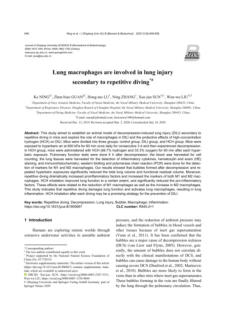

Author: Oliwia Pinkowska
This document presents a literature review on the risk
factors associated with decompression sickness (DCS) in
recreational scuba diving. It outlines the methodology
used to gather relevant studies, summarizes the findings
regarding various risk factors, and concludes with the
need for further research to clarify the roles of gender and
fat mass in the development of DCS symptoms.
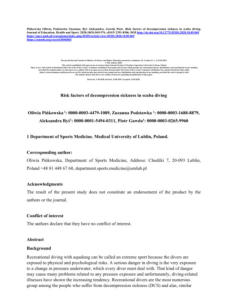

Author: Abdullah Arjomand, James R. Holm, and Anthony
J. Gerbino
This report analyzes a severe case of decompression
sickness (DCS) in a diver, which was complicated by shock
and respiratory failure. It describes the case's clinical
presentation, treatment, and outcomes, highlighting the
pathophysiology and the need for specific medical
interventions such as aggressive fluid resuscitation and
hyperbaric oxygen therapy. It also underscores the
importance of considering hyperbaric oxygen treatment
even in critically ill patients with DCS.
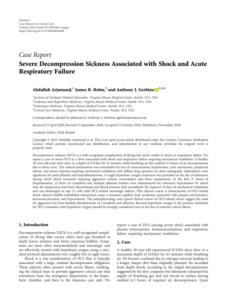

Authors: Kaiming Liu, Brian Z. Wang, Yishu Hao, Shuijiang
Song, & Mengxiong Pan
This document summarizes and analyzes the relationship
between migraine and patent foramen ovale (PFO),
including potential pathophysiological mechanisms,
clinical features, and the effects of PFO closure on
migraine attacks. It highlights the need for further research
to clarify the causal relationship and optimize patient
selection and treatment strategies.
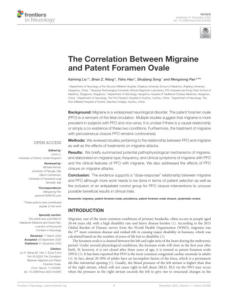

Author:
Charlotte Sadler, Miguel Alvarez Villela, Karen Van Hoesen,
Ian Grover, Michael Lang, Tom Neuman, Peter Lindholm
The information report provides guidelines for evaluating
scuba divers' fitness to return to diving after a COVID-19
infection. It highlights the unique physiological challenges
of scuba diving, the potential long-term effects of COVID-
19 on pulmonary and cardiac health, and the need for
medical evaluations based on the best available evidence
and past experiences with similar illnesses.
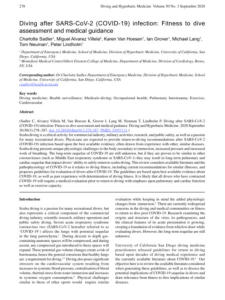

Author: Arina B. Favilla and Daniel P. Costa
This document reviews and synthesizes current scientific
understanding of the thermoregulatory strategies
employed by marine air-breathing vertebrates during
diving to highlight the challenges these animals face due
to the thermal conductivity of water and the physiological
demands of diving, such as maintaining thermal balance.
It also seeks to encourage further research in this area,
mainly through physiological biologgers, to better
understand how these animals manage conflicting
physiological demands to maintain homeostasis.
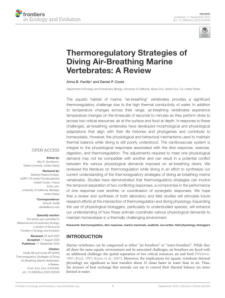

Author: Kubra Ozgok-Kangal , Kubra Canarslan-Demır,
Taylan Zaman , Kemal Sımsek
This study analyzes the long-term effects of occupational
diving on pulmonary functions to investigate how factors
such as diving experience, smoking history, and
occupational groups (commercial divers and SCUBA
instructors) impact respiratory health. It outlines the
methodology, results, and conclusions of the research,
highlighting that long-term diving experience is associated
with changes in pulmonary function test parameters,
specifically related to small airway obstruction, while
smoking and occupational groups do not significantly
influence these parameters.
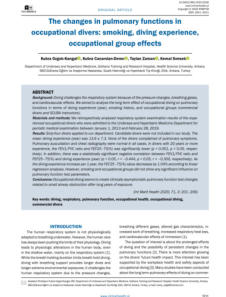

Authors: Ran Arieli, Soliman Khatib, Aatef Khattib, Elena
Bukovetzky, Orna Dally Gottfried
This document introduces a scientific hypothesis
regarding the potential role of lung surfactant
dipalmitoylphosphatidylcholine (DPPC) in the
development of autoimmune diseases, particularly type 1
diabetes. It outlines a proposed mechanism by which
DPPC may contribute to autoimmune responses and
suggests that further investigation into this hypothesis
could lead to new therapeutic opportunities and includes
preliminary findings from a study comparing DPPC levels
in diabetic patients and control subjects, indicating a
potential link between DPPC levels and the onset of type 1
diabetes.
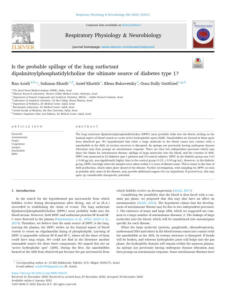

Authors: Arnau Carreño, Mireia Gascon, Cristina Vert, and
Josep Lloret
This study evaluates the effects of scuba diving on mental
health, particularly in comparison to beach activities, to
highlight the potential mental health benefits of scuba
diving and beach activities, especially for individuals with
chronic or psychiatric illnesses who are on regular
medication. Additionally, it discusses the environmental
impacts of scuba diving practices and the methodology
used to assess mental health outcomes.
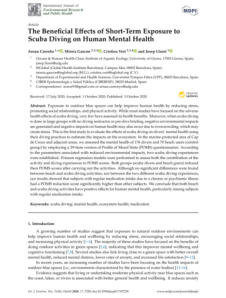

Authors: Catherine Ashton, Neil Banham, Merrilee
Needham
This paper presents a medical study on spinal cord
infarction (SCI), discussing its causes, diagnosis, and
potential treatments to share findings from a review of
cases at Fiona Stanley Hospital, highlighting the outcomes
of different treatment approaches, particularly the use of
hyperbaric oxygen treatment (HBOT), pentoxifylline, and
cerebrospinal fluid (CSF) drainage. The conclusion
suggests that these treatments may reduce disability in SCI
patients and calls for further research through prospective
trials.
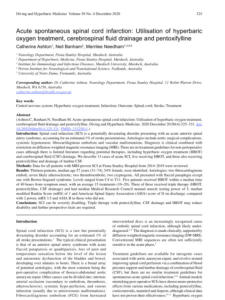

Authors: Kresna Febriyanto, Ainur Rachman, Ferry Fadzlul
Rahman
This study investigates the human errors committed by
traditional divers while fishing and their relationship to
occupational accidents at sea to identify specific types of
human errors and the resulting accidents, using statistical
analysis to establish a significant correlation between these
errors and the occurrence of accidents.
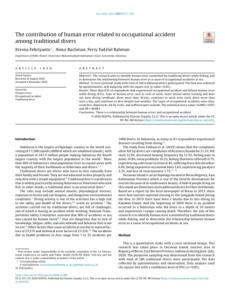



07 - Livedo Racemosa – The Pathophysiology of Decompression-
Associated Cutis Marmorata and Right/Left Shunt
- Published by Frontiers
Author: Frank Hartig, Norbert Reider, Martin Sojer,
Alexander Hammer, Thomas Ploner, Claus-
Martin Muth, Herbert Tilg, and Andrea Köhler
Decompression sickness and arterial gas embolism, known
as decompression illness (DCI), can have various
symptoms. Cutis marmorata (CM) is mistakenly used for
livedo racemosa (LRC), which is pathological. A study of
divers showed a high correlation between R/L shunts and
livedo racemosa. All divers with unexplained DCI had R/L
shunts. The findings suggest a clear link between skin
lesions and R/L shunt. Thus, the term cutis marmorata is
incorrectly applied in diving medicine.
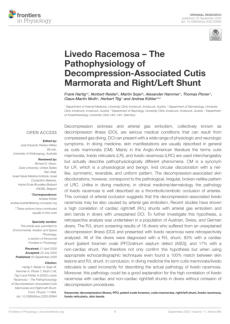



08 - Gas in Joints After Diving: Computed Tomography May Be
Useful for Diagnosing Decompression Sickness.
- Published by Science Direct
Author: Kei Jitsuiki, Yoshihiro Kushida, Ryota Nishio,
Youichi Yanagawa
A 26-year-old experienced scotoma scintillans after diving.
Symptoms ceased after smoking, but he later had a
headache, fatigue, and pain. He called an ambulance. A
doctor found bubbles in his inferior vena cava. He was
transported to the hospital by ground ambulance. CT
showed gas in various joints. He received treatment and
was discharged with no symptoms the next day. This
report notes CT's potential to detect gas in multiple joints
after diving.
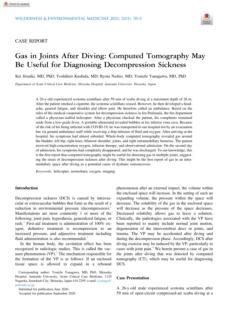



09 - Pre-hydration strongly reduces decompression sickness
occurrence after a simulated dive in the rat
- Published by Diving and Hyperbaric Medicine.
Author: Qiong Wang, François Guerrero, Michaël
Theron
Hydration status may affect the risk of decompression
sickness (DCS), but evidence is limited. This study
examined how pre-hydration impacts DCS in rats, finding
that it significantly reduced DCS severity and increased the
number of animals without DCS symptoms.
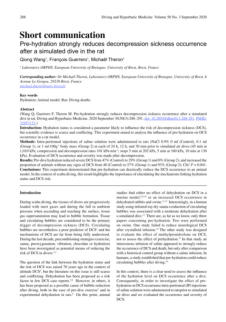



36 - Cutis marmorata as a manifestation of decompression illness
- Published by Emergency Care Journal

Author: Antonio Villa, Mara Fiocchi
Skin lesions due to decompression illness (known as cutis
marmorata) are transient alterations that could be a
warning sign of a more severe manifestation of
decompression illness.
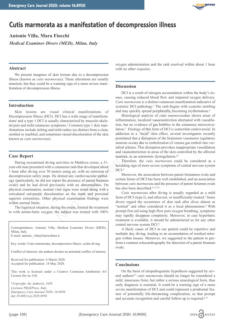



37 - Decompression illness treated at the Geneva hyperbaric facility
2010–2016: A retrospective analysis of local cases
- Published by Diving and Hyperbaric Medicine.
Author: Julian Thaler, Rodrigue Pignel, Marie-Anne
Magnan, Michel Pellegrini, Pierre Louge
This document discusses a study of patients treated with
hyperbaric oxygen for DCI from 2010 to 2016, analyzing
data for case descriptions and factors linked to negative
outcomes. Severe DCI had high rates of lasting deficits,
but no single factor predicted a bad outcome. A
Boussuges score over 7 predicted an unfavourable
outcome in spinal DCI with 90% sensitivity and 53%
positive predictive value.
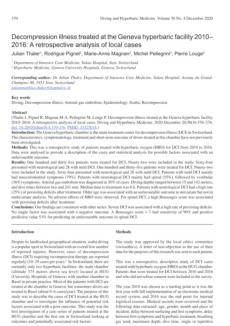


01 - Hyperbaric oxygen therapy for Crohn’s disease complications:
What do we know? – Authors’ reply
- Published by the US United European Gastroenterology Journal - Sage
Author: CA Lansdorp and RA van Hulst
The authors thank Parra et al. for their interest in their
article on using hyperbaric oxygen (HBO) therapy for
wounds in metastatic perineal Crohn’s disease. They note
that HBO has been used in treating inflammatory bowel
disease for over ten years but is not yet widely approved.
Current evidence is mixed, with many studies being small
and biased. The authors agree on the need for high-
quality research and are open to conducting a larger
study on HBO for metastatic Crohn's disease. They
mention an upcoming publication on the HOT-TOPIC trial
related to perianal fistulas.
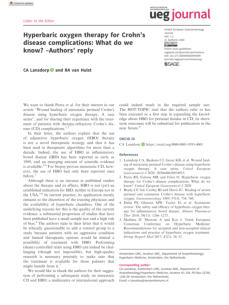



04 - The Mechanism of NMDA Receptor Hyperexcitation in High
Pressure Helium and Hyperbaric Oxygen
- Published by Frontiers
Author: Alice Bliznyuk, Michael Hollmann, and Yoram
Grossman
Professional divers exposed to pressures greater than 1.1
MPa may suffer from high pressure neurological
syndrome (HPNS) and CNS hyperbaric oxygen toxicity
(HBOTox). HPNS is characterized by reversible CNS
hyperexcitability, cognitive and motor deficits. Recent
studies have shown that NMDARs containing GluN1 +
GluN2A subunits can increase responses by up to 50% at
high pressure (HP) He, while GluN1 + GluN2B responses
are not affected. The researchers propose that HPNS and
HBOTox may share a common mechanism, involving the
removal of Zn2+ from its binding site on the N-terminal
domain of the GluN2A subunit, leading to larger currents
and hyperexcitation.
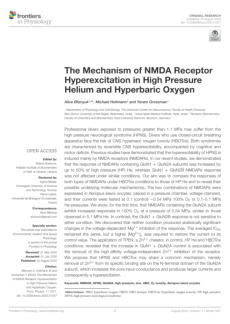


17 - Hyperbaric Oxygen Treatment Improves Intestinal Barrier
Function After Spinal Cord Injury in Rats
- Published by Frontiers
Author: Xuehua Liu, Fang Liang, Jing Zhang, Zhuo Li,
Jing Yang, and Nan Kang
This study investigates the impact of hyperbaric oxygen
(HBO) treatment on intestinal barrier function after spinal
cord injury (SCI), and involved rats and a SCI model. The
animals were divided into three groups: sham-operation
group, SCI group, and SCI+HBO group. After surgery, the
animals were assessed for neurological function and
intestinal permeability. Results showed that HBO
treatment significantly inhibited the expression of Rho
and ROCK1, increased occludin and ZO-1 expression,
decreased permeability, and alleviated intestinal mucosal
injury compared to the SCI group.
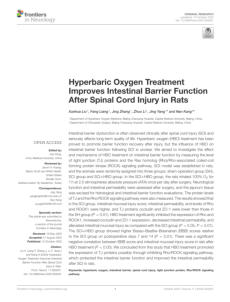


30 - Impaired consciousness when scuba diving associated with
vasovagal syncope
- Published by Diving and Hyperbaric Medicine
Author: Peter Wilmshurst, Margaret Clamp
Drowning in scuba diving is likely due to impaired
consciousness, which could be caused by toxic effects of
breathing gas or arterial gas embolism. Four scuba divers
experienced episodes of impaired consciousness
underwater, with three experiencing recurrent episodes
of vasovagal syncope on land.
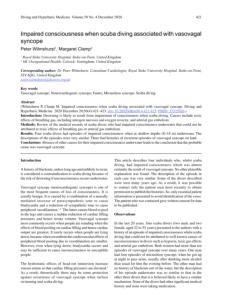


31 - Extensive Simulated Diving Aggravates Endothelial Dysfunction
in Male Pro-atherosclerotic ApoE Knockout Rats
- Published by Frontiers
Authors: Simin Berenji Ardestani, Vladimir V. Matchkov,
Kasper Hansen,Nichlas Riise Jespersen, Michael
Pedersen, and Ingrid Eftedal
The study investigates the impact of 7-weeks simulated
diving on endothelial function and mitochondrial
respiration in atherosclerosis-prone rats. The researchers
found that both ApoE knockout (KO) diving and non-
diving rats showed changes in endothelial function, but
the diving group showed larger changes. Altered nitric
oxide signaling was primarily involved in these changes,
while mitochondrial respiration remained unaltered. The
findings suggest that extensive diving may aggravate
endothelial dysfunction rather than promote adaptation
to oxidative stress.
